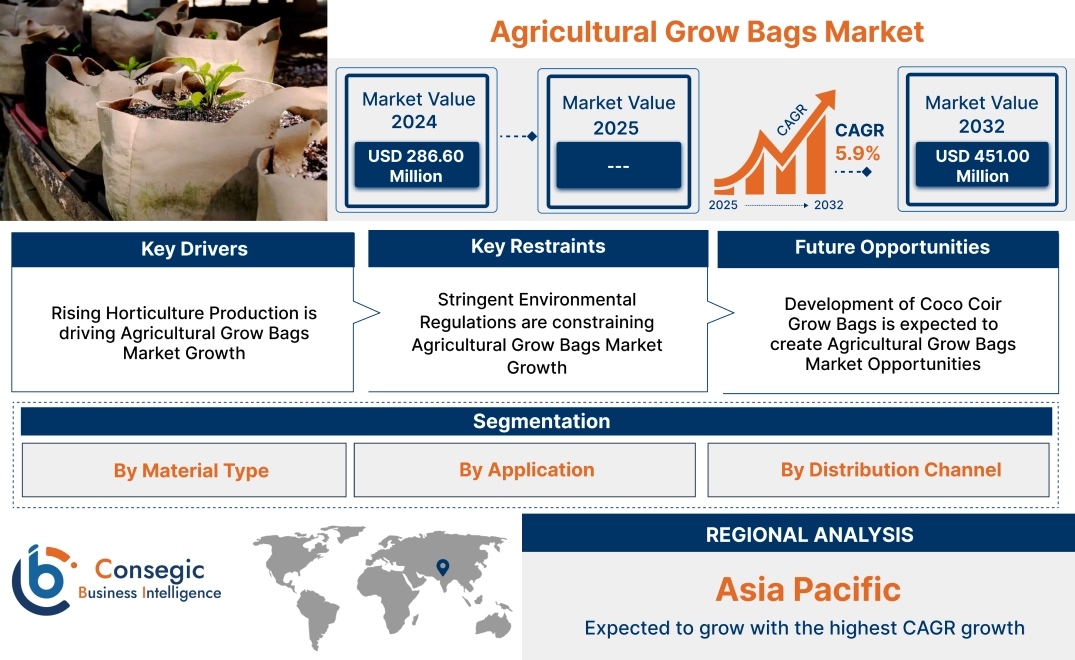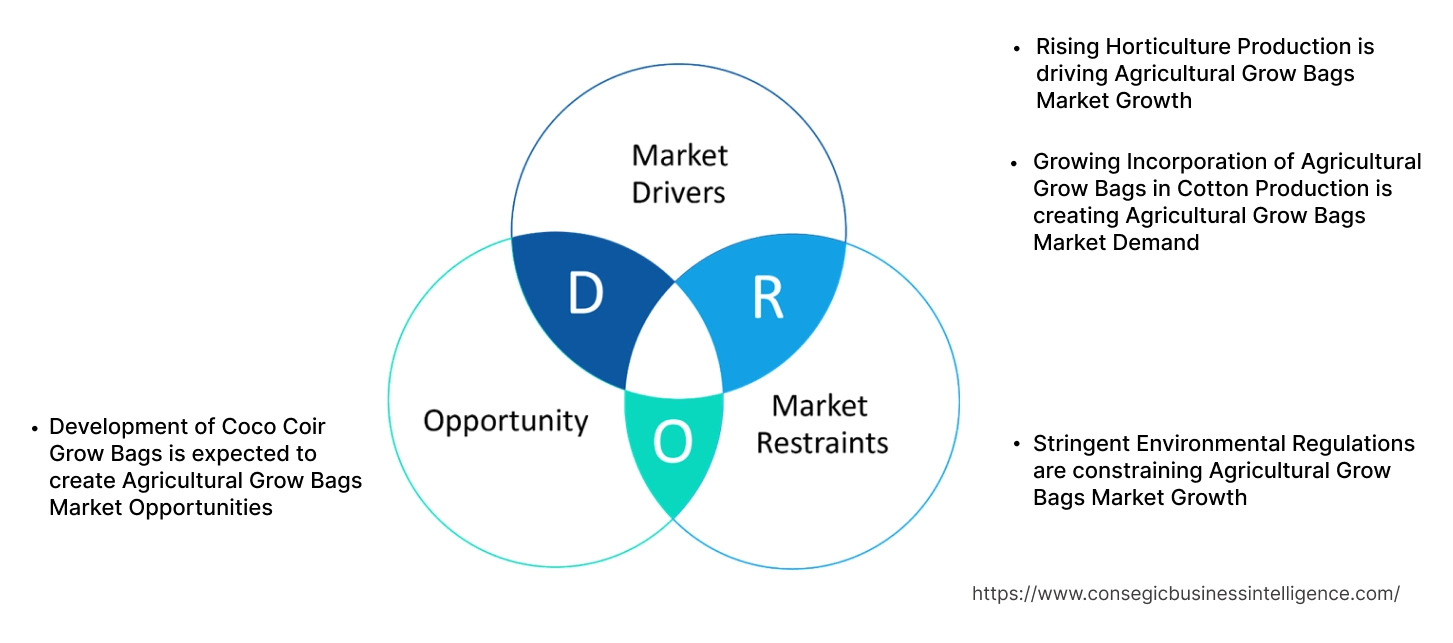Agricultural Grow Bags Market Size:
Agricultural grow bags market size is estimated to reach over USD 451.00 Million by 2032 from a value of USD 286.60 Million in 2024, growing at a CAGR of 5.9% from 2025 to 2032.
Agricultural Grow Bags Market Scope & Overview:
Agricultural grow bags are large, portable bags which provide controlled environment for plant growth. They offer proper drainage, root aeration, and durability in plant cultivation. Agricultural grow bags are made of either plastic or fabric material. Due to optimal aeration and improved water efficiency, they are used in cultivation of vegetables & fruits, commercial crops, and others. Agricultural grow bags are distributed through supermarkets, specialty stores, E-commerce, and others. There are different advantages of using these bags such as enhanced water retention, space efficiency, reusability, and improved plant health. Moreover, rising focus towards sustainability and growing eco-friendly practices is leading to adoption of bio-based agricultural grow bags further driving the market.
How is AI Transforming the Agricultural Grow Bags Market?
AI is being utilized in the agricultural grow bags market, primarily for optimizing the overall growing environment and improving crop yields. Moreover, AI-powered systems can analyze soil samples and provide recommendations on nutrient levels, moisture content, and other factors, which can further help in optimizing the growing conditions within the grow bags. Additionally, AI can analyze data from sensors in the grow bags to optimize irrigation schedules, in turn ensuring plants receive the right amount of water while minimizing waste. Therefore, the above factors are expected to create lucrative prospects for market growth in upcoming years.
Agricultural Grow Bags Market Dynamics - (DRO) :
Key Drivers:
Rising Horticulture Production is driving Agricultural Grow Bags Market Growth
Horticulture production mainly consists of fruits, vegetables, ornamental, and medicinal plants. As global demand for horticulture increases due to population proliferation, farmers are adopting agricultural grow bags to provide controlled and efficient growing environment for plants.
- In 2023, according to Ministry of Agriculture & Farmers Welfare, the horticulture production in India is increased by 39% as compared to the year 2022. Agricultural grow bags are used in the horticulture production for better root growth and nutrient absorption, leading to higher yields and healthier crops.
Thus, rising horticulture production is leading to agricultural grow bags market demand supported by higher yields and better root development in plants.
Growing Incorporation of Agricultural Grow Bags in Cotton Production is creating Agricultural Grow Bags Market Demand
Cotton production refers to the process of harvesting and cultivating cotton which is obtained from the seed hair of cotton plants. Grow bags are used in cotton production providing a controlled environment, ensuring proper drainage and aeration. Cotton production is growing due to population growth, increasing globalization and government support further driving the market.
- In 2023, according to United States Department of Agriculture, the cotton production in China is increased by 6.3% as compared to the year 2022. Grow bags are widely used in cotton production for healthy root development in the cotton plants to enhance crop productivity and improved yields.
Hence, growing incorporation of agricultural grow bags in cotton production is leading to agricultural grow bags market expansion supported by rising production and enhanced crop productivity.
Key Restraints:
Stringent Environmental Regulations are constraining Agricultural Grow Bags Market Growth
Environmental regulations are a major restraint in the market, particularly regarding plastic material. Traditional grow bags are typically made from non-biodegradable material such as polypropylene and high-density polyethylene contributing to environmental pollution. Regions such as Europe, North America, and others have introduced stringent rules and regulations regarding the single-use plastics and non-recyclable materials. With the growing focus on sustainability, the manufacturers are required to adopt eco-friendly practices, invest in cleaner technologies and explore renewable sources. This results in high investment costs and delays in the production process of agricultural grow bags.
Thus, environmental regulations are restraining the agricultural grow bags market expansion, due to regulatory standards and high cost.
Future Opportunities :
Development of Coco Coir Grow Bags is expected to create Agricultural Grow Bags Market Opportunities
Coco coir is a natural fiber extracted from the outer husk of coconut. Grow Bags made up of coco coir are biodegradable, renewable, and ideal for horticulture and hydroponics. As global demand for sustainable agricultural practices rises, coco coir grow bags cater to environmentally conscious consumers and align with green initiatives.
- In 2024, Rx Green Technologies launched coco coir grow bags. These agricultural grow bags offer excellent water retention, aeration, and root development in the plants leading to higher yields.
Thus, development of coco coir grow bags is expected to create agricultural grow bags market opportunities through improved aeration and sustainable solutions.
Agricultural Grow Bags Market Segmental Analysis :
By Material Type:
By material type, the market is divided into plastic and fabric.
Trends in Material Type:
- According to agricultural grow bags market trends, plastic is widely used material due to affordability and reusability.
- Incorporation of fabric is rising in agricultural grow bags due to biodegradability and breathability as per market trends.
Plastic accounted for the largest market share in the year 2024.
- Plastic is a synthetic material made from various organic polymers, like polyvinyl chloride, polyethylene, and others.
- It is a widely used material in the agricultural grow bags due to its affordability, lightweight nature, and versatility.
- Polyethylene, polypropylene and polyvinyl chloride are most commonly used plastics in grow bags.
- Further, rise in the production of plastic globally contributes to overall development of the market.
- For instance, in 2021, according to Plastics Europe, the global plastic production increased by 4% as compared to the year 2020. Plastic is widely used in agricultural growing bags which ensures effective water retention, aeration, and prevent soil leakage in crop production.
- Thus, plastic is a widely used material in the market due to effective water retention and soil leakage.
The fabric is expected to grow at the fastest CAGR over the forecast period.
- Fabric is a material produced by weaving together cotton, nylon, wool, silk, or other threads.
- Use of fabric such as jute and coir is growing in agricultural grow bags due to their breathability and lightweight nature.
- This fabric ensures proper aeration which promotes healthy root growth by preventing overwatering and root rot.
- Non-woven fabric grow bags are especially adopted because of durability, affordability, and eco-friendliness.
- Additionally, natural fibers like jute and coir provide excellent water retention and are biodegradable, aligning with sustainable farming practices.
- Thus, use of fabric is growing in the market due to sustainable farming practices and eco-friendliness.
By Application:
By application, the market is divided into vegetables & fruits, commercial crops, and others.
Trends in Application:
- As per market trends, agricultural grow bags are widely used in the cultivation of vegetables and fruits to improve aeration and drainage.
- Use of agricultural grow bags is growing in production of commercial crops to provide controlled growing environment according to agricultural grow bags market trends.
The vegetables & fruits accounted for the largest market share of 48.99% in the year 2024.
- Vegetables are edible parts of plants such as roots, stems, or leaves, while fruits are mature ovary-bearing seeds which are consumed raw or processed.
- Agricultural grow bags are widely used in the cultivation of vegetables and fruits due to their portability, water efficiency, and ability to support controlled growing environments.
- These bags are essential for tomatoes, cucumbers, peppers, and others to promote a healthier root system by improving aeration and drainage.
- Further, the rise in the production of tomatoes is contributing to the proliferation of the market.
- For instance, in 2021, according to European Commission, tomatoes production in Europe is increased by 17.9% as compared to the year 2020. Agricultural grow bags are widely used in the production of tomatoes for water efficiency and improving aeration.
- Thus, agricultural grow bags are widely used in the cultivation of vegetables and fruits to improve root system and water efficiency.
The commercial crops is expected to grow at the fastest CAGR over the forecast period.
- Commercial crops are agricultural crops grown for sale & profit and include sugarcane, cotton, tea, and others.
- Agricultural grow bags are being rapidly used in the production of commercial crops especially in controlled environments like greenhouses, vertical farming, and urban agriculture.
- These bags provide optimal aeration, drainage, and space efficiency enabling higher yields and healthier plants.
- Agricultural growing bags are particularly beneficial for high value crops like strawberries, blueberries, and herbs which require precise growing conditions.
- The portability of growing bags allows farmers to maximize space utilization and adopt innovative farming practices, such as hydroponics and rooftop farming.
- Thus, adoption of agricultural grow bags is growing in the production of commercial crops for space utilization and optimal aeration.
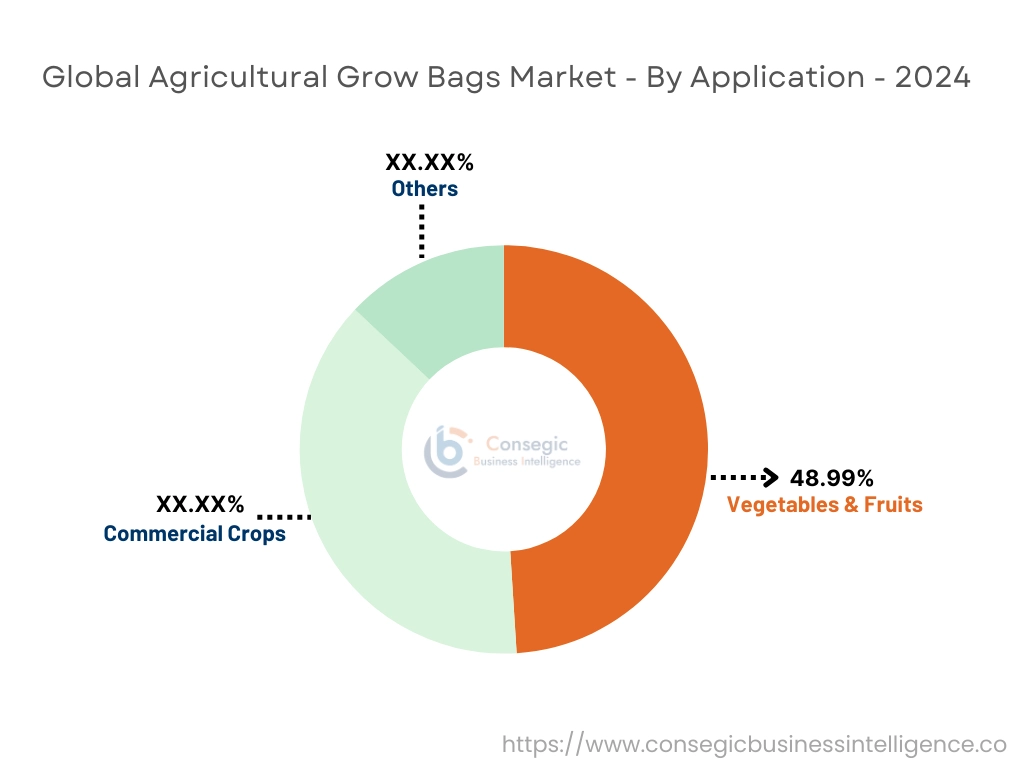
By Distribution Channel:
By distribution channel, the market is divided into supermarkets, specialty store, E-commerce, and others.
Trends in Distribution Channel:
- Agricultural grow bags are distributed widely through supermarkets through effective supply chain.
- Customers are increasingly preferring E-commerce for the purchase of agricultural grow bags due to convenience and easy accessibility.
The supermarket accounted for the largest market share in the year 2024.
- Supermarket is a large retail store offering a wide variety of food, beverages and household products.
- Agricultural grow bags are widely distributed through supermarket to customers and small-scale farmers directly.
- They are widely used in the urban and suburban areas due to their accessibility, product variety and convenience.
- Many supermarkets stock agricultural grow bags catering to the rising demand for home gardening and urban farming.
- Their supply chain networks ensure consistent availability of products and offer both branded and eco-friendly grow bags.
- Thus, agricultural grow bags are widely distributed to customers supported by product variety and convenience.
E-commerce is expected to grow at the fastest CAGR over the forecast period.
- E-commerce refers to the buying and selling of goods and services online through digital platforms and marketplaces.
- Adoption of e-commerce is growing in the distribution of agricultural grow bags due to wider reach and customer convenience.
- Farmers and urban gardeners are easily accessing grow bags of different sizes, materials, and prices, along with detailed product descriptions and user reviews.
- Further, growing E-commerce sales is contributing to the adoption of agricultural grow bags among the customers.
- For instance, in 2024, S. Department of Commerce, e-commerce sales in the United States increased by 7.5% as compared to the year 2023. The agricultural grow bags are distributed through e-commerce to the farmers, urban gardeners, and other customers.
- Thus, the adoption of E-commerce is growing in the market due to wider customer reach and detailed product descriptions as per trends.
Regional Analysis:
The regional segment includes North America, Europe, Asia Pacific, Middle East & Africa, and Latin America.
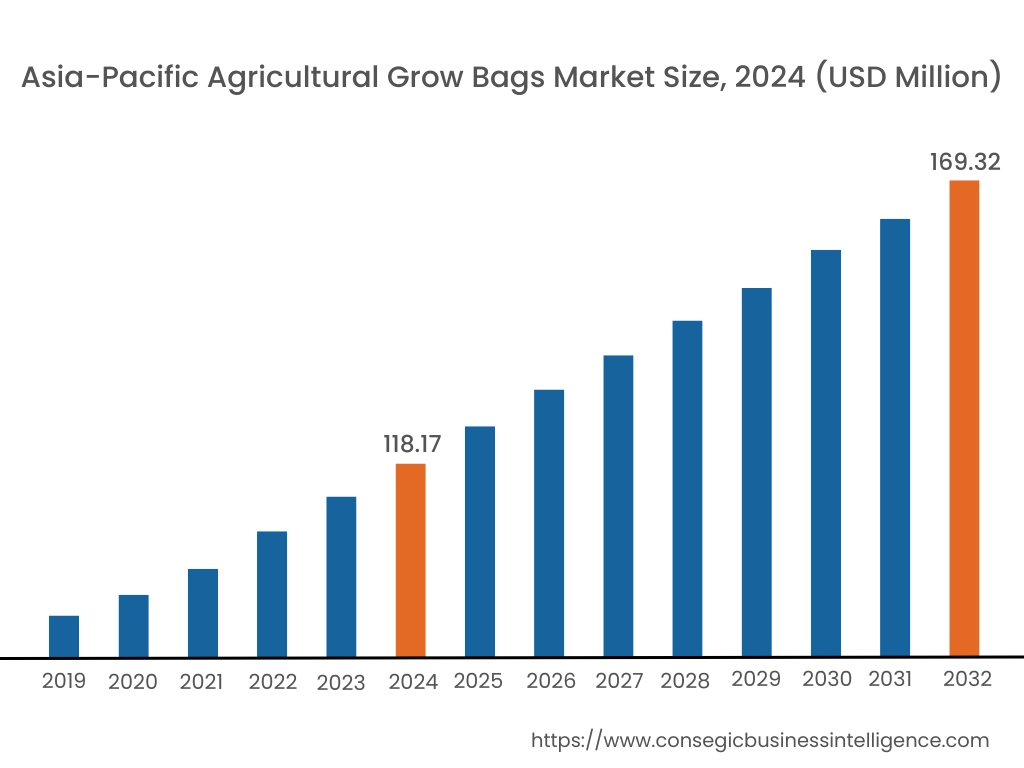
In 2024, Asia-Pacific accounted for the highest market share at 41.23% and was valued at USD 118.17 Million, and is expected to reach USD 169.32 Million in 2032. In Asia-Pacific, the China accounted for the highest market share of 31.34% during the base year of 2024.
The agricultural grow bags market share of Asia-pacific is significant driven by its large population and increasing food industry. Countries such as China and India are leading in agricultural output, supported by favorable climatic conditions and government initiatives. Further, rising production of strawberries in the region due to increased exports and rising consumer preference is driving the market.
- In 2022, according to World Population Review, production of strawberries in China is increased by 3% as compared to the year 2021. Agricultural grow bags are widely used in the production of strawberries to improve drainage and root health.
Hence, Asia-pacific is dominating in the market driven by increased crop production and government initiatives as per analysis.
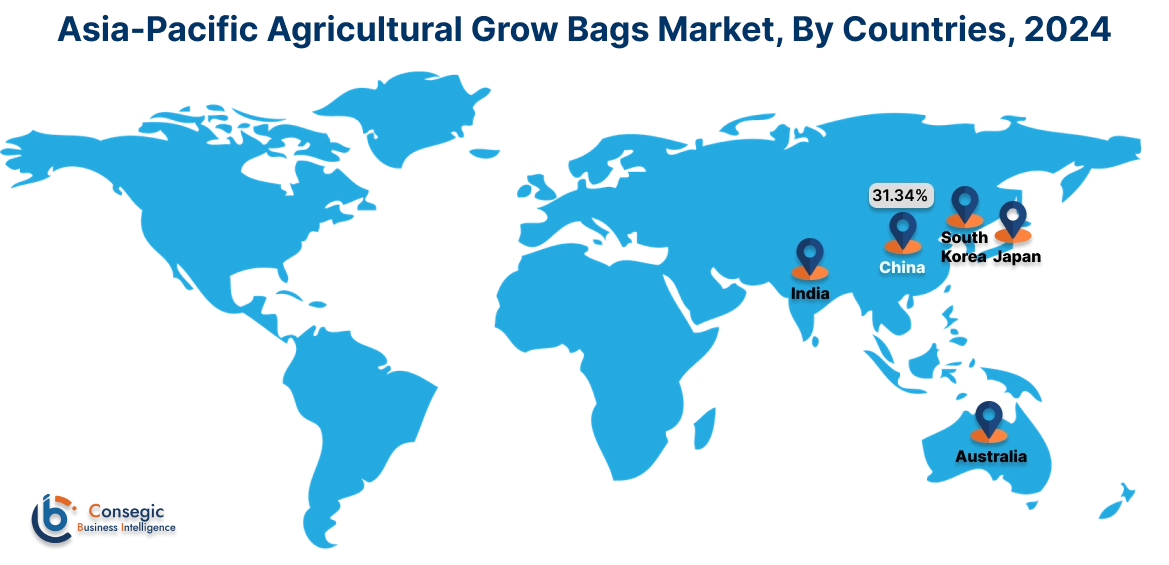
North America is expected to witness the fastest CAGR over the forecast period of 8.2% during 2024-2031.
According to agricultural grow bags market analysis, North America is growing considerably in the market driven by advancements in technology. Innovations in grow bags such as fabric bags, have enhanced the performance and biodegradability. These advanced grow bags offer precise root development, nutrient absorption, and improved crop yield. Additionally, advanced farming such as vertical and rooftop farming have led to the adoption of grow bags in farming practices. Hence, agricultural grow bags market share of North America is expected to emerge rapidly through advanced farming practices and sustainable grow bags as per analysis.
As per agricultural grow bags market analysis, the Europe region is growing rapidly in the market driven by rising adoption of advanced farming practices and strong focus on sustainability. Farmers are increasingly utilizing precision agriculture, vertical farming and hydroponics to enhance crop yields. Stringent environmental regulations such as the European Green Deal promotes the use of eco-friendly and sustainable grow bags, minimizing the environmental impact. Additionally, Europe regions’ commitment of reducing carbon emissions and promoting sustainable agriculture is driving the adoption of bio-based agricultural grow bags.
The Middle East & Africa region is experiencing moderate growth in the market driven by increasing crop production, exports, and government initiatives. Countries such as South Africa, Egypt, and Saudi Arabia are focusing on boosting agricultural productivity to meet rising food demand and strengthen exports. Governments are providing subsidies to agricultural organizations and private firms. Additionally, growing investments in precision agriculture and rooftop farming is fueling demand in the market as per analysis.
As per market analysis, Latin America is growing steadily in the market driven by rising disposable incomes and steady economic development across the region. Increasing purchasing power enables farmers to invest in advanced agricultural grow bags such as fabric grow bags to enhance crop productivity and reduce crop losses. Countries such as Brazil, Mexico, and Argentina are leading the market supported by government initiatives and funding for sustainable farming practices.
Top Key Players and Market Share Insights:
The agricultural grow bags industry is highly competitive with major players providing products to the national and international markets. Key players are adopting several strategies in research and development (R&D) and product innovation to hold a strong position in the global agricultural grow bags market. Key players in the agricultural grow bags industry include-
- Rain Science Grow Bags (United States)
- Dolphin Plastics (Australia)
- Van der Knaap Group (Netherlands)
- WHS Australia (Australia)
- Laizhou Guoliang Packing Products Co. Ltd. (China)
- Dutch Plantin (Netherlands)
- JIFFY GROUP (Netherlands)
- Bloem LLC (United States)
- The Green Yard (Belgium)
- FibreDust LLC (United States)
Recent Industry Developments :
Business Expansion:
- In 2024, Van der Knaap Group expands production capacity for sustainably produced coco substrates through construction of new factory in the Philippines. This will result in increased production of coco-based agricultural grow bags.
Launches:
- In 2022, Roomi Studio launched the mushroom gateway grow kit. Each kit contains agricultural grow bags for mushroom cultivation, a beginner’s guidebook and other products.
Agricultural Grow Bags Market Report Insights :
| Report Attributes | Report Details |
| Study Timeline | 2019-2032 |
| Market Size in 2032 | USD 451.00 Million |
| CAGR (2025-2032) | 5.9% |
| By Material Type |
|
| By Application |
|
| By Distribution Channel |
|
| By Region |
|
| Key Players |
|
| North America | U.S. Canada Mexico |
| Europe | U.K. Germany France Spain Italy Russia Benelux Rest of Europe |
| APAC | China South Korea Japan India Australia ASEAN Rest of Asia-Pacific |
| Middle East and Africa | GCC Turkey South Africa Rest of MEA |
| LATAM | Brazil Argentina Chile Rest of LATAM |
| Report Coverage |
|
Key Questions Answered in the Report
How big is the agricultural grow bags market? +
In 2024, the agricultural grow bags market is USD 286.60 million.
Which is the fastest-growing region in the agricultural grow bags market? +
North America is the fastest-growing region in the agricultural grow bags market.
What specific segmentation details are covered in the agricultural grow bags market? +
Material type, application, and distribution channel are covered in the agricultural grow bags market.
Who are the major players in the agricultural grow bags market? +
Rain Science Grow Bags (United States), Dolphin Plastics (Australia), and Dutch Plantin (Netherlands) are some of the major players in the market.
